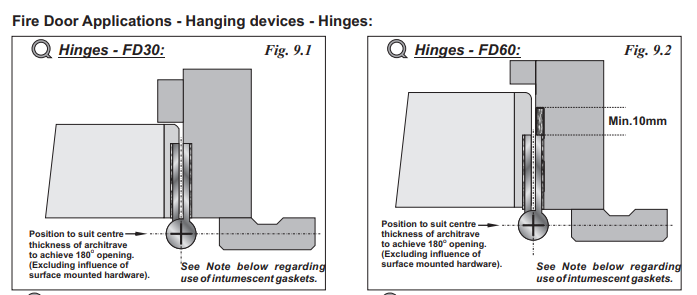-
Posts
446 -
Joined
-
Last visited
Everything posted by Neil ashdown
-

What should gap be under pivot hinge fire door.
Neil ashdown replied to a topic in Fire Doors and Accessories
In terms of the threshold gap for fire doors and compliance to BS 8214: 2016, there is no distinction between doors with top & bottom pivots and doors with butt hinges. -
This would depend chiefly on whether smoke seals would provide a benefit to life safety at this location. So its a fire risk assessment question.
-
Hi Phoebe, For fire resistance purposes the max gap is generally 10mm, so you could fit a threshold plate to the floor to reduce the gap and then fit a flexible seal to address the cold-smoke spread issue. BS 8214: 2016 sections 9.5.3 and 12.3 refer.
-
The applicable Standard is BS 8214: 2016 which recommends a maximum of 4mm and minimum of 2mm.
-
I would support the fire risk assessor's recommendation from a safety improvement aspect.
-
The pocket-door system has evidence of fire resistance performance referencing to an IFC Report. Ask the product supplier for a copy of that report to see how wide the scope is for the product's field of application.
-
If the work is done to joinery workshop standards then the repair could be suitable. Suitable timber would need to be used for the jambs, with seamless edges and faces, with no gaps or voids and fixed with suitable steel fixings to the supporting wall through the joint, at approx 100mm from the top/bottom and max 600mm centres with minimum 50mm penetration into the wall substrate. Only undertake this type of repair where you have specialist knowledge and experience including about intumescent sealing, smoke sealing and door frame to wall sealing requirements.
-

space between fire door frame and opening
Neil ashdown replied to a topic in Fire Doors and Accessories
In terms of the requirements of BS 8214 the fire rating applies to the door. -
Be careful using timber lipping. There are requirements that timber lipping has a minimum density, min and max dimensions and that a suitable adhesive is used.
-
A drop-seal will not resolve the issue of the door being non-compliant in terms of the 10mm gap for fire resistance purposes.
-

Are specific fire door gaps a legal requirement?
Neil ashdown replied to a topic in Fire Doors and Accessories
This matter is dealt with in the Standard BS 8214: 2016 https://landingpage.bsigroup.com/LandingPage/Undated?UPI=000000000000226297 -
Below is an excerpt from 'Fire Safety in Purpose Built Blocks of Flats' https://assets.publishing.service.gov.uk/government/uploads/system/uploads/attachment_data/file/1020410/Fire_Safety_in_Purpose_Built_Blocks_of_Flats_Guide.pdf A flat entrance door that opens directly to an outside area would also serve as a final exit. Therefore, as Tom says 'a fire door is not required........' unless the door is required to protect other persons or properties.
-

Good security locks for fire doors
Neil ashdown replied to fei's topic in Fire Doors and Accessories
Many fire doors have limitations about what products may be fitted in terms of security locks. Often the lock is allowed only to be installed at a position between 800mm & 1200mm from the bottom edge of the door and there will be a limit to the lock-set dimensions. For this reason many of the fire doors seen with a cylinder night latch rim lock are non-compliant to the door manufacturers' evidence of fire resistance performance. So in terms of the door you have had installed and improving security, it will be necessary to check with the door manufacturer about what type of locks may be fitted and at what positions. Some door leaves do have evidence of fire resistance performance with additional mortice dead locks fitted, but many do not. However, the fire door industry have been aware of this issue for some time therefore dual certification PAS 24 Secure By Design fire doors are available. So when specifying new fire rated flat entrance door-sets, one should add this where it is a requirement. -

Fire doors in a domestic 3 storey house
Neil ashdown replied to a topic in Fire Doors and Accessories
In a three storey house, in scope of building regulations, doors opening onto the staircase, landings and hallway should be fire doors. This is so that the doors, when closed, would protect the entire escape route from top floor to the entrance door from fire spread. So if the kitchen opens onto that route, then it should have a fire door. Also, any door inside the house to an integral garage should be a thirty minute fire door with self-closer and smoke seals. -
Not sure about regulations but the use of intumescent seals dates from the 1980s I believe. This link might help? https://www.ifsa.org.uk/
-

Are specific fire door gaps a legal requirement?
Neil ashdown replied to a topic in Fire Doors and Accessories
The guidance document 'BS 8214: 2016 Timber-based fire door assemblies - Code of practice' recommends a gap of 2mm to 4mm, so on this basis 4.2mm would be non-compliant. However, this article may be useful https://afdi.org.uk/fire-door-industry-news/fire-doors-what-is-compliance/ -
I am not aware of any evidence of fire performance that deals with gaps around hinges but clearly the expectation would be that the mortice work for any door ironmongery should be as tight as possible with no large gaps. Below is from https://www.falconpp.co.uk/media/1328/09_strebord_v91_section_9_hardware_rev_a.pdf so applies to that particular door.
-

Fire Door Flush Tolerance
Neil ashdown replied to Kevin Bayley's topic in Fire Doors and Accessories
You are correct Kevin, some fire door data sheets fail to deal with this issue. Where this is the case the door leaf should not stand proud of the door frame at any point. Some fire doors have an allowance of 1mm proud - I am yet to see a more generous allowance. -
Personally, I would change them because the installation instructions for modern fire doors requires No.8 x 30 / No. 10 x 40 or 50. Also see section 2.3.9 'Hinges' at http://firecode.org.uk/Code_of_Practice_hardware_for_fire_and_escape_doors.pdf
-
From what you say I would assume that the fire door has no markings or label? If it had/has you could consult the manufacturer's installation instructions or product data sheet for the door leaf and this will provide the specification for hinges. For example, depending on the door core and/or door stiles material, the hinges may need to be No. 10 rather than No.8 and 40mm or 50mm instead of 30mm. So in terms of best practice, check whether the door has timber stiles or is just chipboard with hardwood lipping. A look along the top edge of the door leaf or removal of any mortice lock/latch should reveal which. If the door has timber stiles No. 8 x 30mm should be suitable but if it is solid chipboard throughout use No.10 x 50mm. For the door frame, the screws should not pass through the jamb to the other side and the screw heads should fit correctly in the recesses of the hinge blades. Also check that the middle hinge is central or above in door leaf height.
-

Making good a fire door after cutting into it
Neil ashdown replied to a topic in Fire Doors and Accessories
Lipping thickness spec has come from https://www.falconpp.co.uk/downloads/ but clearly applies to those particular doors so consult the door leaf manufacturer where that's possible. However, where you are unable to do so the information about lipping thickness, adhesives and timber species can be applied as good practice. -
This can be a troublesome issue and as you say the gap (according to BS 8214) should be 4mm maximum with the smoke seal fin just in contact with the meeting edge of the opposing leaf. First, make sure that the smoke seal is fitted to one leaf only and not both. Then make sure you are using a single fin smoke seal to reduce friction. If that doesn't work change the self-closer for one that has latching adjustment - the door should close steadily (not fast) and the latching adjustment should pull the door shut at the point where it is almost-closed.
-
Assuming its a timber-based door - If you are able to consult the installation instructions or data sheet for the fire door leaf you can check that the existing hinges are suitable. If you cannot trace the door leaf manufacturer to do this and the hinges are in good condition you could retain them, although personally I would change them because most timber fire doors have a limit on the dimensions of the hinge knuckle.
-

National recognised qualification
Neil ashdown replied to Andrew Barber's topic in Fire Doors and Accessories
There is an NVQ available for fire door installation but it this is not widely taken up, possibly because there are easier tasks and there is currently no statutory requirement to hold a dedicated qualification or certification to be able to install, maintain and inspect fire doors. However, you are correct the industry is working on this so keep an eye on things!



